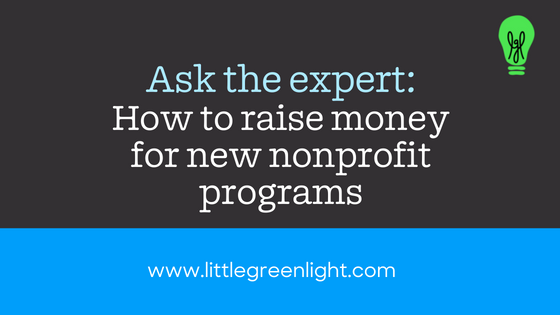Little Green Light is a cloud-based donor management system for fundraisers.
Subscribe to get our latest product updates, best practices and tips to grow your nonprofit.

Fundraisers know that specifics help raise money. Asking for “a gift to help our nonprofit” is less effective than asking for “a gift of $100 to provide meals to four families this month.” But what if your nonprofit wants to try a new idea or program? How can you raise money when you don’t have specifics yet?
When Little Green Light hosted its Meet the Author webinar with author Erik Hanberg, attendees submitted so many great questions for the Q&A portion that we couldn’t answer them all in our allotted time. Thankfully, Erik was available to respond to additional questions on our blog, and we’re excited to continue sharing his practical nonprofit expertise with you in our Ask the Expert series.
In this post Erik will be answering Sandra, who asked:
Hi Sandra,
I love that you’re thinking about growth and reaching for new ideas.
I’m going to give you the easiest way first—just raise more money overall and fund the program. I don’t mean for that to sound flippant, but it really is the easiest way to start. If you can increase overall giving through major gifts, the annual appeal, or a fundraising event such as a breakfast, you can probably find some room with the new revenue to create new programs. (There are ideas on how to do all of those things in The Little Book of Gold, which is available to Little Green Light customers for free in 2022!)
And then, when you’ve done something new and interesting that you’re proud of, you can shop that around to your donors as another success, which will continue your fundraising success. I call this the easier path because you’re asking donors to support something that already exists and to help you make it better. It’s harder to convince a donor to put money toward a program that is not yet in existence.
But! Since you ask, here’s how I’d raise money for a new program or idea that may or may not materialize.
The first step is to, as much as you possibly can, remove the risk that it won’t materialize. That usually involves paring down the idea to a very basic pilot project. How can you test your idea without additional staffing? What expenses would you need covered outside of that to make your idea happen? Equipment, rental fees, marketing, contractors? Now you have a clear number. Hopefully, this is a couple to a few thousand dollars at most.
To cover that, you should expect to put up some funds from your regular operating budget. Enough to get you part of the way to your goal. Consider turning to the board next. Those are donors whom you can ask to fund something like this, and (if framed correctly as a pilot project) they should be more understanding than other donors if it doesn’t quite work. Then look for some other big donations or grants to get you the rest of the way there. Finally, consider opening it up to your wider donor base to get you to your goal if you think the idea is particularly exciting.
Hopefully, by this point, you have the funds for a pilot. Or, if you don’t, you are close enough that you can cover the rest using operating funds.
Now that the pilot is ready to launch, you’re going to want to document the heck out of it. Plan to get data from the participants before and after (if that’s appropriate for the idea). Get testimonials from the participants about what it means to them. Find a videographer or a photographer who will help document the day (if you can’t afford one, work with a volunteer to take photos, even if they aren’t professional quality.)
If you can emerge from a pilot project with all of that, your chances of getting additional funding for the program later goes way way up. Because now you’re not just trying to raise money for a program or idea that may not materialize—instead, you’re building on success. And you have the data, stories, and photos to prove it.
Good luck!
Erik
If you missed our webinar with Erik, be sure to check it out. And, if you’re looking for more great advice from someone who knows the ins and outs of fundraising, we encourage you to read Erik’s book, The Little Book of Gold. Forbes rated it as a Top 12 Must-Read Book for Nonprofit Employees, and it’s full of practical, actionable fundraising wisdom.
If you’re using Little Green Light, we also want to point you to LGL’s Companion Guide to The Little Book of Gold. Each chapter of Erik’s book covers an essential aspect of fundraising, and our companion guide offers corresponding chapters showing how to use Little Green Light to implement Erik’s advice.
Download a FREE digital copy of Erik’s book, The Little Book of Gold, along with LGL’s Companion Guide (further down on the same page).
Your free copy of The Little Book of Gold is available throughout 2022.
Ready to try LGL? Get your first 30 days free. No credit card required.